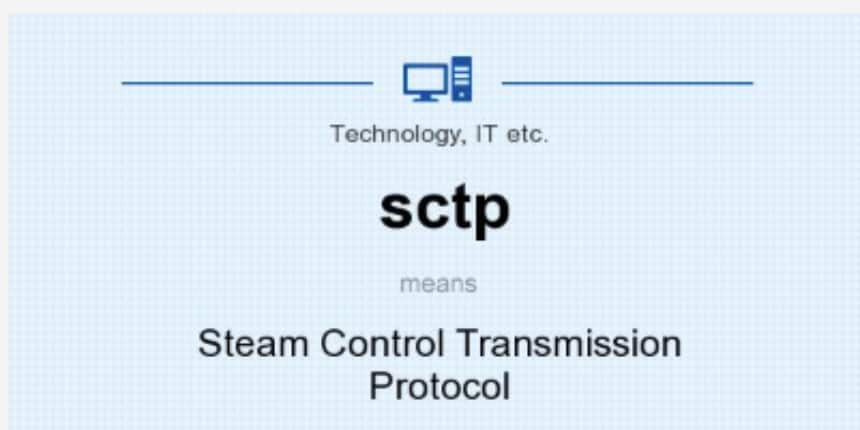SCTP Full Form
The Steam Control Transmission Protocol is the full form of SCTP. Connection-oriented, SCTP is a protocol found in computer networks. It makes it possible to establish a connection in the network using full-duplex association, which includes multiple sequential transmissions of data from one endpoint to the other simultaneously.
This Story also Contains
- RFC 4960 Describes SCTP
- Basic SCTP terminology
- Creating an SCTP Association
- SCTP Packet Structure
- Error Control
- Features
- Advantages
- Disadvantages

Telephonic communication over the Internet is also supported by SCTP, which is also known as the next generation of TCP or TCPng. Voice transmission is required in order to simultaneously transmit a telephone conversation and other data on both ends. A dependable connection can be quickly established using the SCTP protocol.
SCTP also makes it easier to manage the transmission of multimedia data while establishing a connection over a wireless network. The standard protocol for SCTP, developed by the Internet Engineering Task Force (IETF), is RFC 2960.
RFC 4960 Describes SCTP
Acknowledged that user data were transferred without error and without duplicates;
Fragmentation of the data to fit the size of the discovered path MTU;
User messages are delivered in a sequential manner across multiple streams, with the option to deliver user messages in the order in which they arrive;
Combining multiple user messages into a single SCTP packet is an option;
Supporting multi-homing at either or both ends of an association allows for network-level fault tolerance.
Basic SCTP terminology
A data unit that is similar to a UDP Datagram in an SCTP packet is a chunk.
Path: A link that connects two IP addresses
The association is the set of routes that connect two network endpoints.
The transmission Sequence Number, or TSN, is a number given to each data chunk so that it can be tracked.
Creating an SCTP Association
A four-step procedure, also known as a handshake, is required for SCTP:
INIT: The client sends a request to the server
A Cookie and a Verification Tag are provided in the INIT ACK response, which specifies the current server state
Client echoes the Cookie in the COOKIE ECHO
COOKIE ACK: The last acknowledgement of the connection.
It's hard to launch a DoS attack.
SCTP Packet Structure
The same packet can hold multiple chunks together.
Control data is conveyed in pieces
Confirmation Tag: A novel identifier for the ongoing Affiliation
Error Control
The transmitter receives an acknowledgement each time a data chunk is received.
The chunk is retransmitted if the transmitter does not receive an acknowledgement within a predetermined time frame (RTO).
A selective acknowledgement is sent to the transmitter if a receiver detects missing data chunks.
Features
Multiple-Property One-to-One Transmission: A point-to-point protocol with multiple routes to the final host.
The transmission is secure: Not only the ordered data can be determined using SACK and Checksums. It also finds data that has been corrupted, damaged, duplicated, discarded, or rearranged. SCTP is better at reordering data than TCP, despite its similarity to TCP.
Aiming at the message: Every message is framed, and the appropriate tabs on the structure and the order of the data stream are adhered to. A different layer of abstraction would be required for this purpose if it had been TCP.
Multi-Homing Assistance: A connection's resilience is independent of the IP layer and can include multiple IP addresses on both ends.
Advantages
Users are able to send and receive data simultaneously because it is a full-duplex connection.
Connections can be half-closed with it.
The application does not have to split messages because the boundaries of the message are preserved.
It shares attributes with both the TCP and UDP protocols.
Path resilience is not dependent on IP layer.
Disadvantages
It necessitates changes to the transport stack on the node, which is one of the main obstacles.
SCTP must be changed in applications to replace TCP/UDP.
To handle multiple streams simultaneously, applications must be modified.
Frequently Asked Questions (FAQs)
SCTP relies on messages, whereas TCP relies on streams. SCTP can handle multiple streams simultaneously and multiplexed streams, whereas TCP can only handle a single data stream per connection. SCTP's stream-aware connection control is one of its most distinctive features.
TCP and UDP lack the additional security features offered by SCTP.
The SCTP kernel extension is controlled and configured with the help of the sctpctrl command. The SCTP kernel extension can be loaded and unloaded with this command. Additionally, this can be used to set or retrieve various SCTP tunable and dump SCTP data.
SCTP was developed in 2000, but it is still restricted to the interconnects of the major telecommunications corporations.
A four-way handshake is used to establish an SCTP connection.